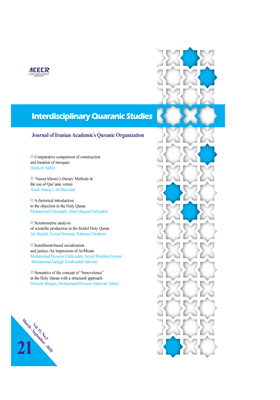A comparison of construction and location of mosques of the early Islamic period and mosques of the Qajar period based on Quran verses
Subject Areas : Quran and Art
1 - tehran univercity
Keywords: Quran verses mosque , Islamic narrations , construction and location,
Abstract :
The mosque is a subject that the Quran has dealt with in a comprehensive manner. One of the aspects of mosque emphasis in the Quran that has received less attention is the issue of construction and location of mosques. This article has been written using the method of descriptive-analytical research and by selecting a case study of the early mosques of the Islamic period and mosques of the Qajar period in Iran. This article has been prepared with the aim of comparative study of two different periods of mosque construction in Iran and also the evolution of their construction based on Quranic verses and Islamic traditions. To analyze the subject, 8 principles of mosque construction were extracted from Quranic verses and Islamic narration, and then the extent and manner of the effect of the extracted principles on the mosques of the Islamic period and Qajar mosques were measured and finally comparatively examined. Based on the results of the research, the Quranic principles of mosque construction were classified into 8 principles, all of which were observed in the samples of early Islamic mosques. If in the mosques of the Qajar period, 4 principles have been observed, which include stability and strength (even in this case, the use of lower quality materials and the use of rapid construction techniques, the strength of mosques compared to previous periods and to Especially in the early Islamic period.
• قرآن کریم
• احمدی ملکی(1378) فرمها و نقشهای نمادین در مساجد ایران، اصفهان، مجموعه مقالات همایش معماری
• اخوت، هانیه؛ محمدرضا بمانیان(1389)، معماری و شهرسازی سنتی در کشورهای اسلامی، تهران: نشر طحان
• اسناد کتابخانه میراث فرهنگی دامغان(1382)، مسجد تاریخانه دامغان
• اسناد کتابخانه میراث فرهنگی نایین(1390)، مسجد جامع نایین
• انیسی، علیرضا(1389)، مسجد جامع فهرج ارزیابی مجدد، نشریه هویت شهر، سال پنجم، شماره 7، صفحات 22-15.
• پیرنیا، محمدکریم(1349) مسجد جامع فهرج، باستانشناسی و هنر ایران، شماره ۵، ۱۳۴۹، ص ۱۳–۲
• حرعاملی، محمد بن حسن(1401 ه ق). وسائل الشیعه الی تفصیل مسائل الشیعه؛ تهران، انتشارات المکتبه الاسلامیه.
• دانشنامه تاریخ معماری و شهرسازی ایران شهر(1399): http://iranshahrpedia.com/fa/indexer
• سرداری، مازیار(1397)، مسجد حاج رجبعلی تهران، انجمن مفاخر معماری ایران: http://ammi.ir
• سمر دلموجی، سلمی(1377)، ساختمان حرم نبوی، مدینه منوره، ترجمه محمدرضا مروارید، بنیاد پژوهش های اسلامی
• صدوق، ابن بابویه(1376)، الأمالی، تهران، کتابچی
• طباطبایی، محمد حسین(1390 ه ق)، المیزان فی التفسیر القرآن، بیروت: مؤسسه الاعلمی للمطبوعات.
• طبرانی، ابوالقاسم سلیمان بن احمد، معجم الکبیر، بیروت، دار احیاء التراث العربی، بی تا
• العسقلانی الکنانی، احمد بن علی بن محمد بن حجر(1407)، فتح الباری شرح صحیح البخاری، قاهره، دارالریان للتراث
• قربان نژاد، پریسا؛ فاطمه جلیل زاده محمدی(1394)، الگوی مکان یابی مساجد همراه با مطالعه موردی مسجد النبی بر اساس آیات، روایات و سیره نبوی، فصلنامه تاریخ فرهنگ و تمدن اسلامی، سال ششم، شماره 18، صفحات 76-47
• قطب، سید(1425 ه ق) فی ظلال القرآن، بیروت: دارالشروق
• گالدیری، اوجینیو(1392)، مسجد جامع اصفهان، مترجم عبدالله جبل عاملی، ویراستار بهنام صدری، ناشر فرهنگستان هنر، دانشگاه آزاد اسلامی
• گدار، آندره (1312)، تاریخانة دامغان ، مهرماه ، سال 1، ش 2
• مبیدی، رشیدالّدین(1339)، کشف الاسرار و عدّه الابرار، به انضمام علی اصغر حکمت، تهران، ۱۳۳۹، ج۱، ص۲۵۶
• مجلسی، محمدباقر(1403) ، بحارالانوار، بیروت، مؤسسة الوفاء.
• مرکز اسناد و مدارک میراث فرهنگی(1382) نقش عجب؛ تهران: سازمان میراث فرهنگی کشور.
• مکارم شیرازی، ناصر(1371)، تفسیر نمونه، تهران: دارالکتب الاسلامیه
• ملازاده،کاظم؛ محمدی،مریم؛حق دوست،زهرا؛عقابی،محمد مهدی(1378)، مساجد تاریخی،پژوهشگاه فرهنگ و هنر اسلامی،سازمان تبلیغات اسلامی،حوزه هنری
• موسوی مقدم، سید محمد؛ مروت محمدی(1395)، بررسی نقش مسجد در افزایش سرمایه اجتماعی بر اساس نماگرهای آن در قرآن و حدیث، نشریه مدیریت سرمایه اجتماعی، دوره 3، شماره 1، صفحات 162-139
• بلخاری قهی، حسن(1388)، مبانی عرفانی هنر و معماری اسلامی، تهران، پژوهشگاه فرهنگ و هنر اسلامی
• هیثی، علی بن ابی بکر(1425 ق)، بغیه الرائد فی تحقیق مجمع الزوائد و منبع الفوائد، بیروت، دارالفکر.
• نجفی، محمد حسن بن باقر(1362 ق)، جواهر الکلام فی شرح شرائع الاسلام، تدوین عباس قوچانی، بیروت، دار احیاء التراث العربی.
• صدوق، محمد بن علی(1413 ق)، من لایحضره الفقیه، تصحیح: علی اکبر غفاری، قم، دفتر انتشارات اسلامی، چاپ دوم.
• H. Imamuddin, Shamim Ara Hassun and Debrashir Sarkar(1985) ‘Community Mosque: A Symbol of Society’, Exploring Architecture in Islamic Cultures: Regionalism in Architecture, Proceedings of the Regional Seminar in the Series Exploring Architecture in Islamic Cultures, Bangladesh University of Engineering and Technology and Institute of Architects, Dhaka, 17–22 Dec. 1985, The Aga Khan Award for Architecture, Concept Media Pte Ltd., Singapore, p. 60.

